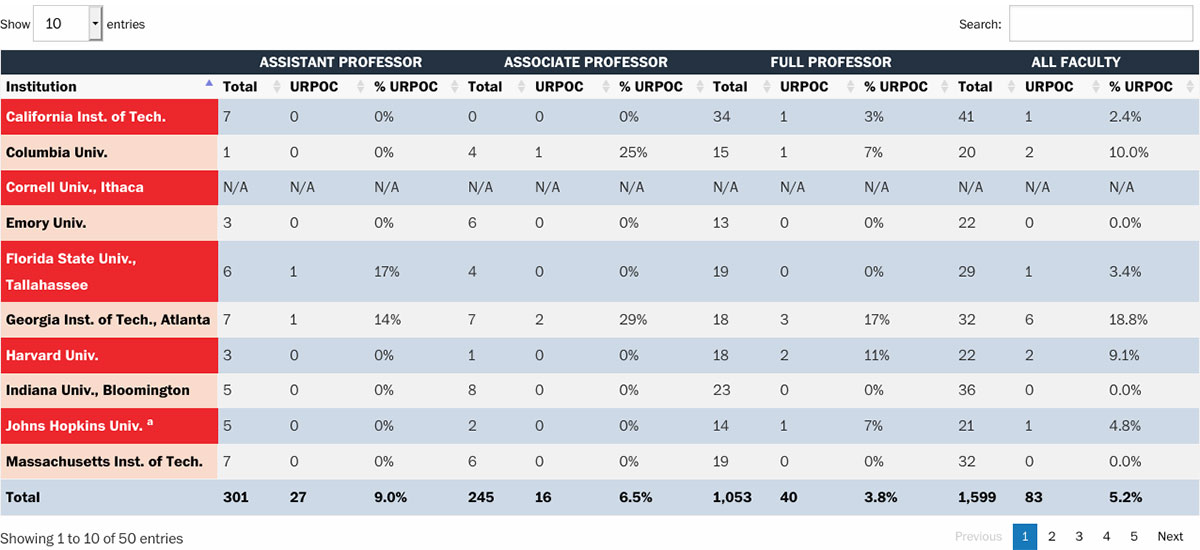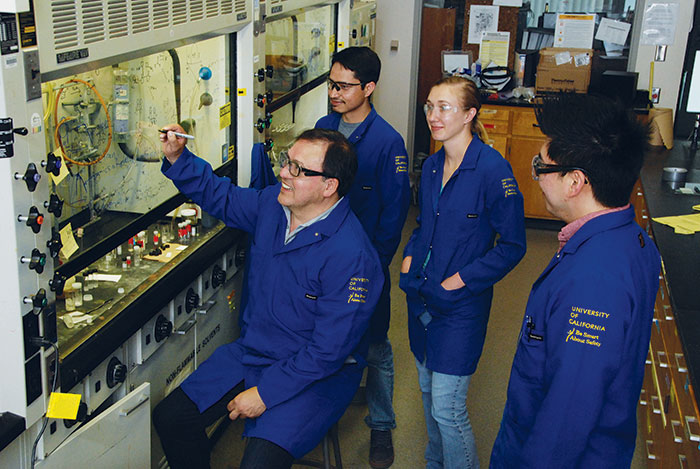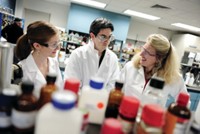Advertisement
Grab your lab coat. Let's get started
Welcome!
Welcome!
Create an account below to get 6 C&EN articles per month, receive newsletters and more - all free.
It seems this is your first time logging in online. Please enter the following information to continue.
As an ACS member you automatically get access to this site. All we need is few more details to create your reading experience.
Not you? Sign in with a different account.
Not you? Sign in with a different account.
ERROR 1
ERROR 1
ERROR 2
ERROR 2
ERROR 2
ERROR 2
ERROR 2
Password and Confirm password must match.
If you have an ACS member number, please enter it here so we can link this account to your membership. (optional)
ERROR 2
ACS values your privacy. By submitting your information, you are gaining access to C&EN and subscribing to our weekly newsletter. We use the information you provide to make your reading experience better, and we will never sell your data to third party members.
Education
Racial and ethnic diversity of US chemistry faculty has changed little since 2011
The Open Chemistry Collaborative in Diversity Equity hopes data will help departments improve faculty’s diversity, inclusion, and equity
by Arminda Downey-Mavromatis , with data analysis by Andrea Widener
November 9, 2020
| A version of this story appeared in
Volume 98, Issue 43
For the past decade, C&EN has worked with the Open Chemistry Collaborative in Diversity Equity (OXIDE) to publish statistics on gender and racial and ethnic diversity of US chemistry faculty. OXIDE collects the data, a task that’s not as easy as it might sound, its leaders say.
Nevertheless, it’s important work, especially with the increased focus from universities on campus diversity efforts after protests about racism and police brutality against Black people this year. “This is definitely a moment of reflection for our nation—and one cannot effectively reflect without knowing the facts,” says Dontarie Stallings, associate director of OXIDE and a teaching professor of chemistry at the University of California San Diego.
The current facts: the racial and ethnic diversity of US chemistry faculty has changed little since 2011.
Racial and ethnic groups in US academia
The percentage of chemistry faculty from some racial and ethnic groups is far behind that of chemistry doctoral degree recipients and the population as a whole.
| American Indian/Alaska Native | Asian/Pacific Islander | Black/African American | Hispanic/Latino/Latina | Multiracial | White, non-Hispanic | |
| Chemistry professors at top 50 schools, 2017–18 a | 0.3% | 16.1% | 1.6% | 3.3% | 0.3% | 78.5% |
| Chemistry PhD recipients, 2018 b | 0.2% | 10.3% | 4.5% | 6.2% | 2.5% | 74.1% |
| Total population, 2018 c | 1.3% | 6.1% | 13.4% | 18.3% | 2.7% | 60.5% |
Chemistry professors at top 50 schools, 2017–18 a
American Indian/Alaska Native: 0.3%
Asian/Pacific Islander: 15.9%
Black/African American: 1.5%
Hispanic/Latino/Latina: 3.2%
Multiracial: 0.3%
White, non-Hispanic: 78.9%
Chemistry PhD recipients, 2018 b
American Indian/Alaska Native: 0.2%
Asian/Pacific Islander: 10.3%
Black/African American: 4.5%
Hispanic/Latino/Latina: 6.2%
Multiracial: 2.5%
White, non-Hispanic: 74.1%
Total population, 2018 c
American Indian/Alaska Native: 1.3%
Asian/Pacific Islander: 13.4%
Black/African American: 6.1%
Hispanic/Latino/Latina: 18.3%
Multiracial: 2.7%
White, non-Hispanic: 60.5%
Sources: Open Chemistry Collaborative in Diversity Equity (OXIDE) survey 2017–18, US National Science Foundation Survey of Earned Doctorates 2018, US Census Bureau National Population by Characteristics 2010–19.
a: Tenured and tenure-track faculty at the 50 schools identified by the US National Science Foundation as having spent the most on chemistry research in fiscal 2016. b: Awarded by US universities to US citizens and permanent residents. An additional 2.2% of PhDs were awarded to chemists of other races or those who did not report a race or ethnicity. c: The sum equals more than 100% because people could choose Hispanic/Latino/Latina in addition to another race or ethnicity.
Racial and ethnic groups in US academia

US chemistry professors from underrepresented racial and ethnic groups

Note: Data are for tenured and tenure-track faculty at the 50 schools identified by the US National Science Foundation as having spent the most on chemistry research in a particular fiscal year. Underrepresented racial and ethnic groups include American Indian/Alaska Native, Black/African American, Hispanic/Latino/Latina, and multiracial. Percentage calculations exclude multiracial individuals who are white/Asian, because they are not considered underrepresented compared with their proportion of the US population. In this survey, Pacific Islanders were counted as Asians so are not included in underrepresented percentages.
OXIDE began documenting diversity among chemistry faculty because although some universities survey their faculty and students to understand their diversity and inclusion climate, such studies can be too general, conflating the diversity, inclusion, and equity challenges of different departments. Generalized climate surveys won’t capture the differences between, for example, an English department and a chemistry department, Stallings says.
To focus on chemistry faculty, OXIDE sends its survey to department chairs at about 130 institutions, though its reporting focuses on the universities with the greatest chemistry research expenditures according to the US National Science Foundation.
The survey asks departments for the gender and race and ethnicity breakdown within each tenure-track faculty rank—assistant, associate, and full professors—using US Census Bureau categories. C&EN publishes the race and ethnicity data on alternate years from gender; the most recent gender breakdown, for the 2016–17 academic year, appeared in C&EN’s May 13, 2019, issue. The race and ethnicity data focus on underrepresented faculty—those whose proportion is lower among faculty than in the US population. This group includes American Indian and Alaska Native; Black and African American; Hispanic, Latino, and Latina; and multiracial people.
The study is not as simple as sending emails and waiting. “It takes around 9 months to collect the data,” Stallings says. The timeline includes following up with departments to emphasize the importance of the data collection. Any gap in participation, Stallings believes, is the result of the survey’s falling through the cracks during department transitions, such as the appointment of a new chair.
Stallings estimates that since 2011, 80% of departments contacted have participated in the study. For the data showing the number of underrepresented people of color among faculty for the 2017–18 academic year, 49 of the top 50 departments contacted completed the survey.
“I found it impressive that our community responded at this level, considering what everyone suspected the overall numbers would demonstrate,” Stallings says. The percentage of underrepresented chemistry faculty of color has increased from 4.4% to only 5.4% in 6 years. The percentage of underrepresented assistant professors of color started off higher and shows greater improvement, from 7.0% to 9.6%. The percentage of associate professors fell from 8.4% to 7.3%, while full professors rose from 2.9% to 3.8%.
Chemistry faculty from underrepresented racial and ethnic groups at top 50 US schools, 2017–18
Georgia Tech continues to lead in the overall percentage of chemistry professors who are underrepresented people of color (URPOC).
To download a pdf version of this story, including this chart, click here.
Chemistry faculty from underrepresented racial and ethnic groups at top 50 US schools, 2017–18

OXIDE began in 2010 through a planning grant from the NSF that included funds from the Department of Energy and National Institutes of Health. When the planning grant ended in 2011, a full grant replaced it, funding the study from 2012 until 2018. The Georgia Institute of Technology and Johns Hopkins University supplemented that funding, as did “small gifts and grants,” according to Rigoberto Hernandez, OXIDE director and a professor of chemistry at Johns Hopkins.
Then the NSF withdrew its funding, and the DOE and NIH with it. “Suffice it to say that NSF felt that we were now a successful program,” Hernandez says, “and that the NSF doesn’t fund successful programs in perpetuity.” The agency wanted OXIDE to be self-sustaining. A search for new sponsorship led OXIDE to the Alfred P. Sloan Foundation, a nonprofit organization that funds science, technology, engineering, and mathematics research and education. That funding was used to support the workshops OXIDE runs, while separate, unrestricted funding is supporting the survey. The Sloan Foundation funding extends through 2022. The researchers are seeking new funding from a variety of sources.
“We’re open to partners who share our vision that by advancing inclusive excellence in academia, it will impact our whole profession,” Hernandez says.
In addition to the faculty diversity surveys, OXIDE runs several workshops and seminars to guide those in academia toward a more inclusive community. The most well known of these events are the National Diversity Equity Workshops, held every 2 years. The multiday events feature lectures by chemists and social scientists who discuss diversity and inclusion efforts in the context of OXIDE’s data. Participants create recommendations to advance inclusion and take those back to their institutions. Hernandez cites as an example the University of Minnesota Twin Cities Chemistry Department Diversity and Inclusion Committee, which was established by then-chair William B. Tolman after he attended a workshop in 2013. (Tolman is now associate dean of research at Washington University in St. Louis.)

On C&EN’s terminology
The term minority has negative connotations and can reinforce the marginalization of people of color when it’s used to describe race and ethnicity. It is also often inaccurate: people of color are the numerical majority in many cases. So C&EN will no longer use underrepresented minority and its associated acronym, URM. We will now use underrepresented people of color and the acronym URPOC. Because OXIDE has not changed how it collects the data, URM and URPOC data can be compared.
The next National Diversity Equity Workshop will be held in a pandemic-safe format in 2021. They also present OXIDE’s mission and findings at smaller seminars across the country each year.
Given that racial diversity among chemistry faculty does not match that of the general population, especially as people of color become the majority in the US, chemistry classrooms and labs are not serving students in the best way to encourage them to become chemists and push the field forward, Hernandez says. Stallings hopes that as COVID-19-related hiring freezes thaw, new hires will include higher proportions of women and underrepresented people of color.No matter what OXIDE finds, the data are available
for academics and activists alike. Several campaigns, including BlackInChem, which celebrates and elevates the voices of Black chemists, and the GRExit movement, which advocates chemistry departments drop the Graduate Record Examinations requirements, have cited the disparities outlined by OXIDE to bolster their messaging. “The reason that we’re collecting the data is to hold people accountable,” Hernandez says.
Correction
The table titled "Racial and ethnic groups in US academia" was corrected on Nov. 13, 2020, to fix two numbers. In the row for total population, the percentage of people who are Asian/Pacific Islanders and the percentage of people who are Black/African American were switched. The percentage of people who are Asian/Pacific Islanders is 6.1%. The percentage of people who are Black/African American is 13.4%.
The table titled "Chemistry faculty from underrepresented racial and ethnic groups at top 50 US schools, 2017–18" was updated on Dec. 4, 2020, to fix numbers for two schools. Specifically, Stanford University has 1 full professor who is an URPOC, not 0, bringing Stanford's chemistry faculty to 1 URPOC out of 23 total, or 4.3%. The University of Maryland, College Park, chemistry faculty who are URPOC include 2, not 0, assistant professors; 2, not 0, associate professors; and 0, not 1, full professors. That brings Maryland's total to 4 URPOC out of 38 total, or 10.5%. Those numbers, in turn, change the percentages in the "Racial and ethnic groups in US academia" table and "US chemistry professors from underrepresented racial and ethnic groups" line chart, which were updated also. Click here to download corrected print pages.





Join the conversation
Contact the reporter
Submit a Letter to the Editor for publication
Engage with us on Twitter